 Restaurant Review
Restaurant Review

" />In between two floors displaying a wide range of Buddhist artefacts, a vegetarian restaurant serves up an array of surprisingly tasty treats, Hari Chathrattil discovers
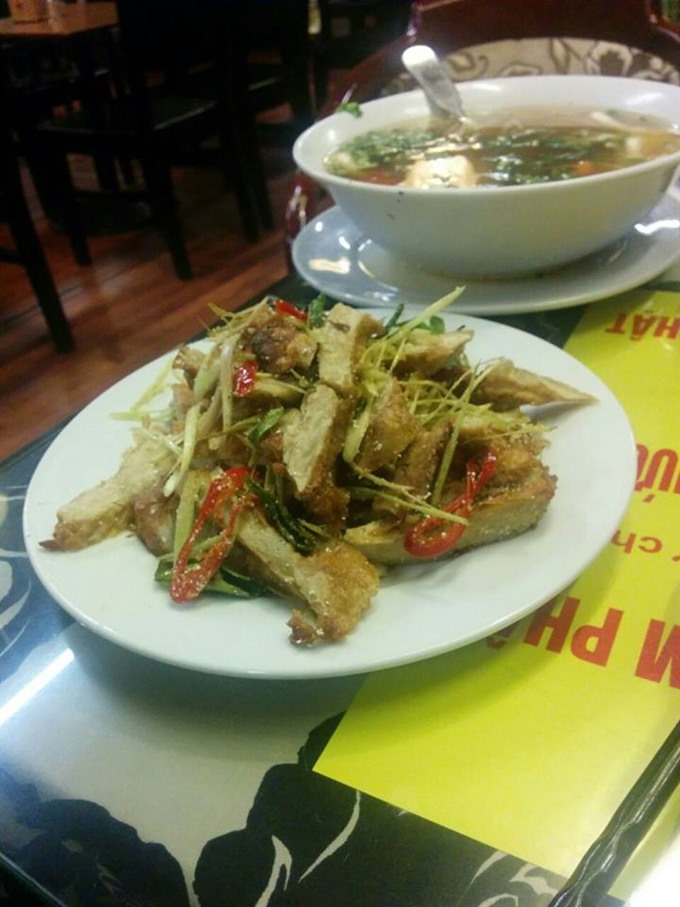 |
| Meaty: A tasty faux chicken dish that looks like the real article. VNS Photo Shobit Nair |
In between two floors displaying a wide range of Buddhist artefacts, a vegetarian restaurant serves up an array of surprisingly tasty treats, Hari Chathrattil discovers
Explosive.
This might not be a word one usually associates with food, but this is a literal explosion I am talking about.
I’d just checked out a vegetarian restaurant near the office and, as is my wont, asked the good folks there if they had something spicy and not sweet to go with the food.
Bubbly, effervescent Giang (who does not work there anymore) said the chef makes a very spicy chilly sauce, but stressed that it was “really spicy” and that I had to be careful.
Used to spicy Indian food and relatively bland Vietnamese cuisine, I was not impressed, but she was not kidding. I dipped the ends of a pair of chopsticks into the sauce and delicately touched the tips with my tongue. Wish I could say it was mouth-watering stuff, but my eyes were the organs thad did the watering. It was the spiciest thing I’d ever had, including a “sexist” sauce proverbially called “Scorned Woman” that I had tasted in the US years ago.
Excited, I bought a whole bottle of the sauce, returned to the office and told my colleagues about it. Sitting at my desk, I opened the bottle to show them how spicy it was. As soon as I removed the lid, it exploded in my face with a loud bang. Having a very spicy sauce splash into your eyes is not an experience I will recommend.
The sauce has since been watered down, both in terms of consistency and taste, but I have become a regular at the Bồ Đề Chay, 65 Quán Sứ Street, next to the eponymous pagoda.
The restaurant is sandwiched between two floors that display the largest array of Buddhist items I have seen. Beautiful works of lacquer, glassware, Buddha statues made of wood and metal, incense burners et al are worth a visit or two on their own. As one climbs the stairs to the restaurant, the walls are graced with artworks that are changed every week or even every day, it is difficult to say.
I’d taken its food for granted, but taking a guest there a few days ago reminded me that it is a pretty decent place to eat.
Shobit Nair, who chose Việt Nam as the first country to travel to outside native India, had never really tried Vietnamese food, and was kinda surprised that there were exclusively vegetarian restaurants here. It was his second day in the country. He’d heard about phở, and tried some bún chả in the Old Quarter, but was not too enamoured of the smell of fish sauce. Kindred spirit, in that regard.
When we got to the restaurant, I was already in a hurry to get back to the office, so I took the easy way out and accepted most of the recommendations made by Bồ Thị Hiền , who’s been working for the establishment for 17 years, since its earlier avatar as a café, and has inside knowledge that we are not privy to.
Since Shobit knows lassi (Indian version of yoghurt smoothies) well, I decided to order one that he’d never had before, something that would surprise his taste buds.
The avocado-soursop combination (VNĐ49,000) lived up to the mild hype I’d built up. “What’s this,” Shobit asked, shaking his head as though he could not believe how good it was. Thick without being too creamy, sweet but not overly so, sour, but in a way that only a soursop can taste, it was the best lassi he’d ever had, he proclaimed. When he said he did not know what a soursop was, I told him it was Mullatha, the latest anti-cancer sensation in Kerala, the Indian state where both of us have our origins.
Shobit’s head-shaking was satisfyingly repeated with each taste of the different dishes served, and his eyes opened in wonder on learning how the same ingredients were treated so differently in two different places (India and Việt Nam).
As we sipped our avocado-soursop lassis, all the food that we’d ordered were brought together to the table, the staff taking to heart my warning that I had no time to loose.
Game to using the highly unfamiliar chopsticks, Shobit picked out a piece of the Gà rang muối (VNĐ50,000), vegan chicken slices topped with ultra-thin strips of lemongrass and some other leaf I could not identify. It could have been some kind of citrus, though. Our guest was more than impressed. This is vegetarian, he asked, almost disbelievingly.
I’ve had the dish several times, and always felt something should be done to make it a little less dry, a little more moist, but not oily. It is still tasty, though.
The Đậu Tứ Xuyên (stewed Sichuan tofu) (VNĐ40,000), which goes well with plain rice, was also satisfying, but this dish also leaves me wanting more of what I think is the "real Schezwan" flavour, involving a lot of dry red chillies. But I am no expert on Chinese food, and am influenced by Indian Chinese cooking. More on this unique fusion later.
The two other dishes – Nộm hoa chuối (banana flower salad) (VNĐ50,000), and Khoai môn chiên (taro balls) (VNĐ50,000), got my guest besides himself with excitement. A young man with an avidly entrepreneurial bent, he exclaimed: “My God! The Gujjus in Mumbai would go to town on this!” (Gujjus are those who hail originally from the Indian state of Gujarat, stereotyped, with some justification as vegetarian and wealthy businesspeople).
Indeed. He was referring to the taro balls that are deep-fried with a batter that could have been made of a mixture of rice and corn flour, I am not sure. Crunchy on the outside, soft on the inside, carrying the natural sweetness of the purple taro, this dish would be a hit anywhere.
Adding to the informal charm of the place is chef Nguyễn Văn Minh, who has this endearing habit of looking at what you are having, and then bringing a bit of something for you to try, either with the existing dish, or just a taste of something new.
Now, I insist on an extra serving of “hành khô”, crispy-fried shallots, with every bowl of bún riêu (crab soup, vegan, of course). At VNĐ30,000 a bowl, it is the dish to have when you are in a hurry. Served in minutes, the rice noodle soup has a slightly sweet broth that can be spiced up with the aforementioned sauce that used to be explosive and continues to be flavourful.
The spacious restaurant offers several “set menus” priced VNĐ30-60,000 to choose from, and I’ve seen that these are quite popular, as is the impressive buffet that is served every day during lunch time. At just VNĐ118,000 for a wide range of soups, salads, special fried rice, stir-fried and steamed vegetables, faux meat dishes including fish cooked with ginger, at least two or three varieties of spring rolls, and three or four or five desserts, it is a steal. The slices of pineapples and/or bananas and/or jackfruit dipped in batter and deep-fried are not to be missed.
Mmmm. Time for my next bowl of spicy hot bún riêu, (fresh vermiceli with paddy field crab meat in tomato broth) With an extra serving of fried, crispy shallots. VNS
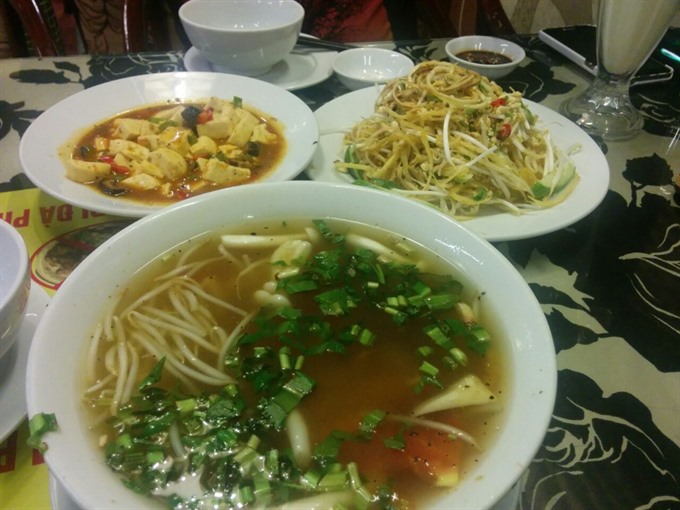 |
| Balanced diet: Banana flower salad for fibre, a Sichuan tofu for protein, and a clear broth with mushrooms, sprouts, tomatoes and greens for minerals. VNS Photo Shobit Nair |
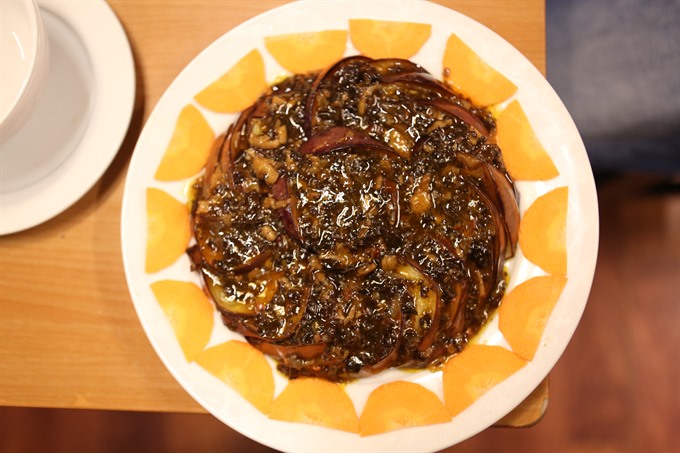 |
| Dark charms: Fried eggplant with a crispy skin and smoky flavours. VNS Photo Việt Thanh |
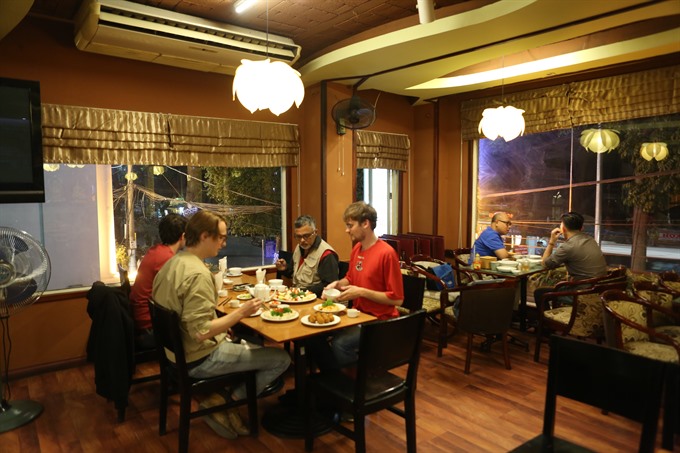 |
| Relaxed ambience: The restaurant is spacious, and a quiet place to have a quiet, sumptuous dinner. VNS Photo Việt Thanh |
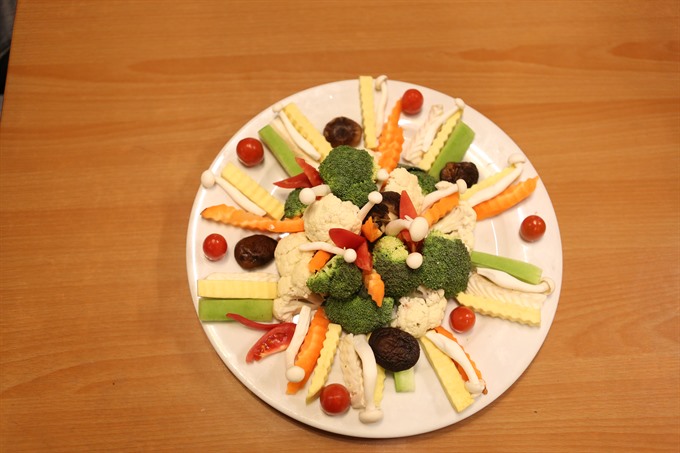 |
| Whetting the appetite: Part of the ingredients for a hotpot designed to get the digestive juices flowing. VNS Photo Việt Thanh |
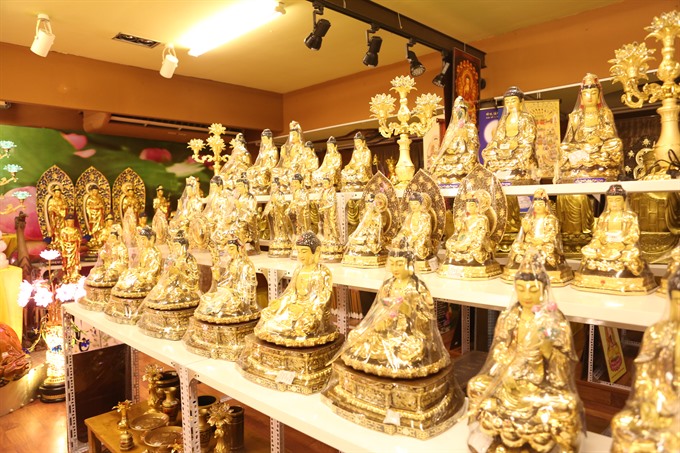 |
| Buddhist gallery: The restaurant is sandwiched between two floors selling all kinds of Buddhist artefacts. VNS Photo Việt Thanh |




